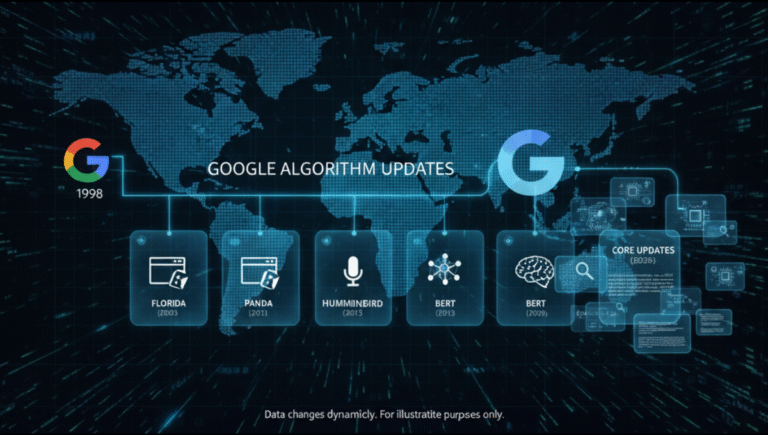In the rapidly evolving digital landscape, staying ahead in search engine optimization (SEO) and understanding how search engines work is crucial for businesses, content creators, and digital marketers alike. Among the search engines, Google dominates with over 90% of global search traffic, making its algorithms an essential focus for anyone aiming to improve visibility online. But one common question persists: How often does Google update its search algorithms?
This article dives deep into the evolution of Google’s search algorithms, exploring their frequency, nature, and implications for webmasters and SEO professionals.
The History of Google Search Algorithms
Google’s journey began in 1998 with the launch of its original algorithm, called PageRank, which ranked pages based on the number and quality of links pointing to them. Over the years, Google has continuously refined and expanded its algorithms to improve the quality, relevance, and safety of search results.
Some of the most notable updates include:
- Florida (2003): Marked as one of the first major algorithm updates, targeting spammy SEO tactics.
- Panda (2011): Focused on content quality, penalizing thin or low-quality content.
- Penguin (2012): Targeted link spam and manipulative link-building practices.
- Hummingbird (2013): Improved understanding of conversational search and context.
- Medic (2018): Focused on health, wellness, and YMYL (Your Money or Your Life) content.
- Bert (2019): Enhanced natural language understanding and contextual relevance.
- Core Updates: Regular, broad updates that tweak search rankings without a specific name, often happening multiple times per year.
How Often Does Google Roll Out Algorithm Updates?
1. Major Algorithm Updates
Google frequently releases major updates that significantly impact search rankings. Historically, these updates have been unpredictable, but in recent years, Google has moved toward a more transparent and consistent update pattern.
Frequency of Major Updates:
- Annual or Semi-Annual Major Updates: Historically, Google has announced or acknowledged several large core updates each year, often around March, June, August, or September.
- Real-Time and Continuous Changes: In addition to these, Google employs real-time updates, especially for features like featured snippets, local search, and mobile rankings.
2. Core Updates
Google’s core updates are broad changes aimed at improving overall search quality. These happen approximately 3-4 times a year. Google typically announces these updates, advising webmasters to focus on providing high-quality, user-focused content.
3. Minor and Algorithm Tweaks
Apart from major updates, Google makes hundreds of minor adjustments daily. These are often unannounced and include small tweaks to ranking signals, such as factors related to page speed, mobile-friendliness, or security.
Daily Changes:
- Google’s Search Liaison, Danny Sullivan, has confirmed that Google makes hundreds of updates daily.
- Many of these are minor and imperceptible, but cumulatively they contribute to the evolving search landscape.
4. Real-Time and Continuous Updates
With the advent of machine learning and AI, Google has shifted toward a more real-time update process. Features like BERT (Bidirectional Encoder Representations from Transformers) and MUM (Multitask Unified Model) enable Google to better understand language and context, leading to ongoing improvements in search results.
Why Does Google Change Its Algorithms So Frequently?
Google’s primary goal is to deliver the most relevant, accurate, and safe results to users. As content, user behavior, and technology evolve, so must the algorithms. Here are some reasons for the frequent updates:
- Combat Spam and Manipulation: To penalize black-hat SEO tactics and spam.
- Improve User Experience: Enhancing relevance, speed, and security.
- Adapt to New Technologies: Incorporating AI, voice search, and mobile-first indexing.
- Address Emerging Trends: Such as misinformation, harmful content, or new search behaviors.
Impact of Algorithm Changes on SEO and Webmasters
Frequent updates require webmasters and SEO professionals to stay vigilant. Some updates may cause fluctuations in rankings, traffic drops, or improvements. However, Google’s emphasis on high-quality, user-centric content means that following best practices generally results in better long-term performance.
Best Practices to Adapt:
- Focus on creating valuable, original content.
- Ensure your website is fast, mobile-friendly, and secure.
- Avoid manipulative SEO tactics.
- Stay updated with official Google communications and industry news.
How to Stay Informed About Google’s Algorithm Changes
Given the unpredictable nature of updates, staying informed is vital. Here are some ways to keep track:
- Google Search Central Blog: Official updates and guidance.
- SEO News Websites: Moz, Search Engine Journal, SEMrush, and others.
- Industry Forums and Communities: Reddit SEO, WebmasterWorld.
- Google Search Console: Monitor your website’s performance and receive notifications.
Conclusion
Google’s search algorithm is a dynamic, ever-evolving system designed to improve the quality and relevance of search results continuously. While major updates occur several times a year, countless minor tweaks happen daily, shaping the search landscape in subtle yet impactful ways.
Understanding that Google updates its algorithms frequently helps webmasters and digital marketers prioritize quality content, adhere to best practices, and stay adaptable. Ultimately, success in SEO is about aligning with Google’s evolving standards—focusing on user satisfaction, technical excellence, and trustworthy content.
Remember: In the world of search, change is the only constant. Embrace it, stay informed, and keep optimizing for the best results.
